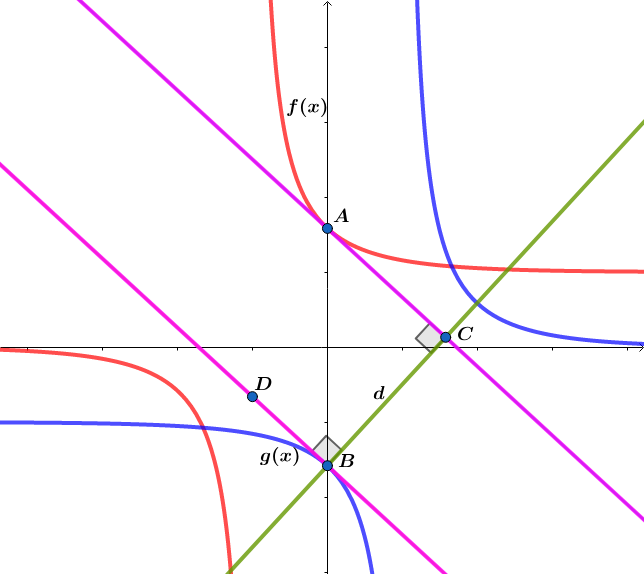Tangent Mania

Let e be Euler's number and ∣ x ∣ < 1 .
Let f ( x ) = lim n → ∞ ∑ j = 1 n ( n j ) n ( e x 1 ) n − j and g ( x ) = lim n → ∞ ∑ j = 1 n ( − 1 ) n − j ( n j ) n ( e x 1 ) n − j
If A C is tangent to f ( x ) at A : ( 0 , f ( 0 ) ) and B D is tangent to g ( x ) at B : ( 0 , g ( 0 ) ) , find the tangent lines to both curves and find the distance d to 6 decimal places.
The answer is 2.327670.
This section requires Javascript.
You are seeing this because something didn't load right. We suggest you, (a) try
refreshing the page, (b) enabling javascript if it is disabled on your browser and,
finally, (c)
loading the
non-javascript version of this page
. We're sorry about the hassle.
Let ∣ x ∣ < 1 .
f ( x ) = lim n → ∞ ∑ j = 1 n ( n j ) n ( e x 1 ) n − j = lim n → ∞ ∑ j = 0 n − 1 ( 1 − n j ) n ( e x 1 ) j = ∑ n = 0 ∞ ( e x + 1 1 ) n = e x + 1 − 1 e x + 1 .
g ( x ) = ∑ n = 0 ∞ ( − 1 ) n ( e x + 1 1 ) n = − ∑ n = 0 ∞ ( e 1 − x 1 ) n = − e 1 − x − 1 e 1 − x .
d x d ( f ( x ) ) = ( e x + 1 − 1 ) 2 − e x + 1 and d x d ( g ( x ) ) = ( e 1 − x − 1 ) 2 − e 1 − x .
Let ( 0 ≤ a < 1 ) ⟹ d x d ( f ( x ) ) ∣ x = a = − ( e a + 1 − 1 ) 2 e a + 1 = d x d ( g ( x ) ) ∣ x = − a .
For a = 0 :
A : ( 0 , e − 1 e ) and B : ( 0 , − e − 1 e )
( e − 1 ) 2 y + e x = e ( e − 1 ) is tangent to f ( x ) at point A and ( e − 1 ) 2 y + e x = − e ( e − 1 ) is tangent to g ( x ) at point B .
The line passing thru B : ( 0 , − e − 1 e ) and ⊥ to A C has slope m ⊥ = e ( e − 1 ) 2 and B C is e y − ( e − 1 ) 2 x = − e − 1 e 2 .
Let D : ( x 0 , y 0 ) be intersection point of the lines:
e y − ( e − 1 ) 2 x = − e − 1 e 2
( e − 1 ) 2 y + e x = e ( e − 1 )
Solving the system we obtain:
x 0 = ( e − 1 ) 4 + e 2 2 e 2 ( e − 1 ) and y 0 = ( e − 1 ) ( e 2 + ( e − 1 ) 4 ) e ( ( e − 1 ) 4 − e 2 )
Using B : ( 0 , − e − 1 e ) and D : ( x 0 , y 0 )
⟹ d 2 = ( B D ) 2 = ( ( e − 1 ) 4 + e 2 ) 2 4 e 4 ( e − 1 ) 2 + ( e − 1 ) 2 e 2 ( ( ( e − 1 ) 4 + e 2 ) 2 4 ( e − 1 ) 8 ) = ( e − 1 ) 2 ( ( e − 1 ) 4 + e 2 ) 2 4 e 4 ( e − 1 ) 4 + 4 ( e − 1 ) 8 e 2 = ( ( e − 1 ) 4 + e 2 ) 2 4 e 2 ( e − 1 ) 2 ( ( e − 1 ) 4 + e 2 ) ⟹ d = e 2 + ( e − 1 ) 4 2 e ( e − 1 ) ≈ 2 . 3 2 7 6 7 0 .